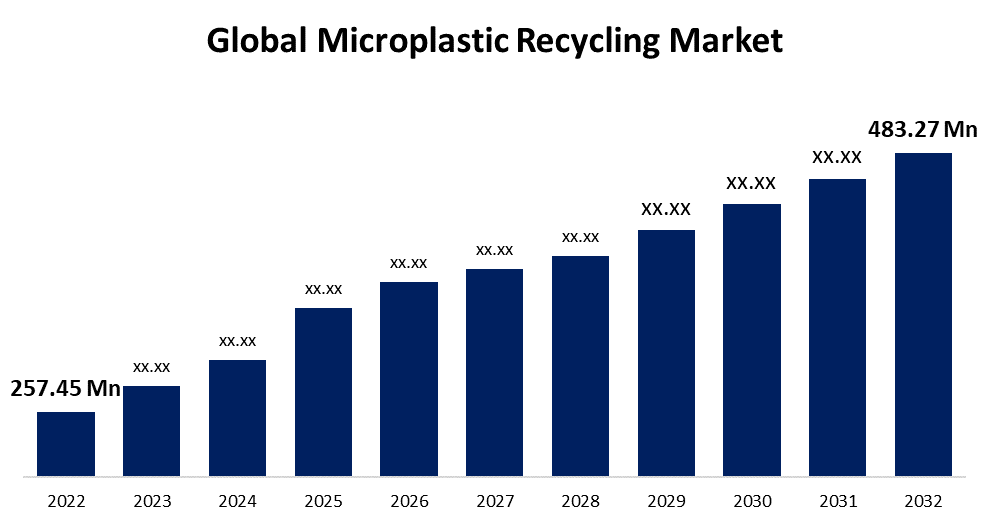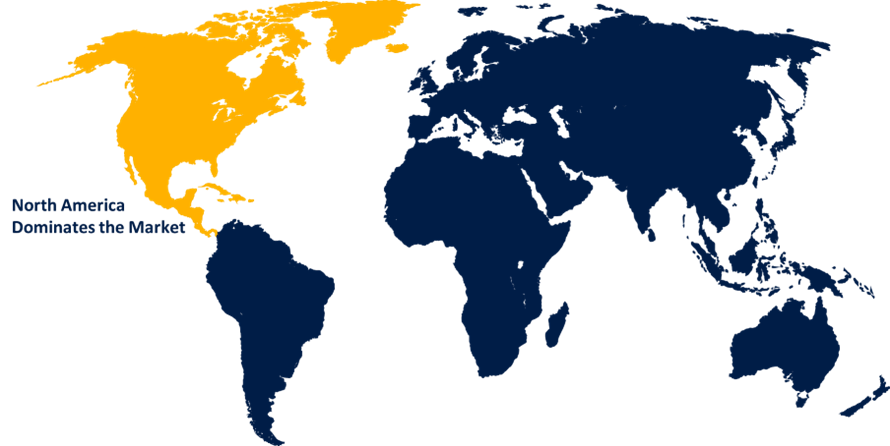Global Microplastic Recycling Market Size, Share, and COVID-19 Impact Analysis, By Product (Primary and Secondary), By End-Use (Packaging, Agriculture, Consumer Goods, Textile, Automotive & Transportation, Building & Construction, and Others), By Region (North America, Europe, Asia-Pacific, Latin America, Middle East, and Africa), Analysis and Forecast 2022 – 2032
Industry: Chemicals & MaterialsGlobal Microplastic Recycling Market Insights Forecasts to 2032
- The Microplastic Recycling Market Size was valued at USD 257.45 Million in 2022.
- The Market Size is Growing at a CAGR of 6.5% from 2022 to 2032
- The Worldwide microplastic recycling Market Size is expected to reach USD 483.27 Million by 2032
- North America is expected to grow significant during the forecast period

Get more details on this report -
The Global Microplastic Recycling Market Size is expected to reach USD 483.27 Million by 2032, at a CAGR of 6.5% during the forecast period 2022 to 2032.
Market Overview
Microplastic recycling refers to the process of collecting and reprocessing tiny plastic particles, known as microplastics, to prevent their environmental harm and promote sustainability. Microplastics are ubiquitous in the environment, found in oceans, rivers, and even in the air we breathe. These minuscule plastic fragments result from the degradation of larger plastic items or are intentionally manufactured for various applications. Recycling microplastics involves several steps, including collection, sorting, cleaning, and processing. Innovative techniques such as filtration, centrifugation, and electrostatic separation are employed to extract and purify microplastics from various sources. Once recovered, these microplastics can be transformed into new products, reducing the need for virgin plastic production and minimizing waste. Microplastic recycling holds great potential in mitigating the environmental impact of microplastics, contributing to the circular economy, and promoting a more sustainable future.
Report Coverage
This research report categorizes the market for microplastic recycling market based on various segments and regions and forecasts revenue growth and analyzes trends in each submarket. The report analyses the key growth drivers, opportunities, and challenges influencing the microplastic recycling market. Recent market developments and competitive strategies such as expansion, product launch, and development, partnership, merger, and acquisition have been included to draw the competitive landscape in the market. The report strategically identifies and profiles the key market players and analyses their core competencies in each sub-segments of the microplastic recycling market.
Global Microplastic Recycling Market Report Coverage
| Report Coverage | Details |
|---|---|
| Base Year: | 2022 |
| Market Size in 2022 : | USD 257.45 Million |
| Forecast Period: | 2022-2032 |
| Forecast Period CAGR 2022-2032 : | 6.5% |
| 2032 Value Projection: | USD 483.27 Million |
| Historical Data for: | 2018-2021 |
| No. of Pages: | 200 |
| Tables, Charts & Figures: | 120 |
| Segments covered: | By Product, By End-Use, By Region |
| Companies covered:: | Carbios, Purecycle technologies, Ioniqa Technologies B.V., Calyxia, Polygonesystems, PlanetCare, ECOFARIO, Ocean Diagnostics, Oceanworks, Matte |
| Pitfalls & Challenges: | COVID-19 Empact,Challenges, Future, Growth, & Analysis |
Get more details on this report -
Driving Factors
The microplastic recycling market is driven by several factors, the growing public awareness about the environmental impact of microplastics and increasing concerns about plastic pollution drive the demand for effective recycling solutions. Government regulations and policies promoting sustainable waste management practices also play a significant role. Additionally, the rising adoption of circular economy principles and the need to reduce dependence on virgin plastics fuel the market's growth. Technological advancements in microplastic collection, sorting, and processing techniques further drive market expansion. Moreover, the increasing demand for recycled microplastics in various industries, such as packaging, textiles, and construction, creates market opportunities. Collaborations between key stakeholders, including manufacturers, recyclers, and research institutions, are fostering innovation and driving the microplastic recycling market forward.
Restraining Factors
The microplastic recycling market faces certain restraints that can hinder its growth. One significant challenge is the complexity of microplastic identification and separation due to their small size and diverse sources. The presence of contaminants and additives in microplastics can also complicate the recycling process. Additionally, the high cost associated with advanced recycling technologies and limited infrastructure for microplastic collection and processing pose barriers to market expansion. Furthermore, the lack of standardized regulations and guidelines for microplastic recycling and the absence of a well-established market for recycled microplastics can impede industry development. Overcoming these restraints requires continued research and development, investment in infrastructure, and collaborative efforts among stakeholders to ensure the effectiveness and viability of microplastic recycling.
Market Segmentation
- In 2022, the secondary segment accounted for around 73.5% market share
On the basis of the product, the global microplastic recycling market is segmented into primary and secondary. The secondary product segment has emerged as a leader in the microplastic recycling market. This segment involves the conversion of recycled microplastics into secondary products, which can be used in various industries. There are several reasons for the segment's market leadership, the demand for sustainable materials and the drive towards a circular economy have led to increased interest in utilizing recycled microplastics as raw materials for secondary product manufacturing. This includes the production of plastic pellets, fibers for textiles, injection molding materials, and more. Moreover, the advancements in recycling technologies have improved the quality and versatility of recycled microplastics, making them suitable for a wide range of applications. The secondary products derived from recycled microplastics often exhibit similar or comparable properties to virgin plastics, making them a viable alternative for manufacturers. This not only reduces the dependence on virgin plastic production but also helps to mitigate the environmental impact associated with plastic waste. Additionally, the secondary product segment has gained traction due to the availability of well-established markets and industries that can readily incorporate recycled microplastics into their production processes. Industries such as packaging, automotive, construction, and consumer goods have shown a growing interest in sustainable materials, creating a significant demand for secondary products derived from recycled microplastics. Overall, the Secondary product segment's leadership in the microplastic recycling market can be attributed to the increasing demand for sustainable materials, technological advancements, and the compatibility of recycled microplastics with various industries and applications.
- In 2022, the packaging segment dominated with more than 60.2% market share
Based on the end-use, the global microplastic recycling market is segmented into packaging, agriculture, consumer goods, textile, automotive & transportation, building & construction, and others. The Packaging end-use segment has emerged as a leader in the microplastic recycling market. This segment encompasses the utilization of recycled microplastics in the manufacturing of packaging materials. There are several key factors contributing to the segment's market leadership, the packaging industry has been under increasing pressure to adopt sustainable practices and reduce its environmental footprint. This has led to a growing demand for eco-friendly packaging solutions, including those made from recycled materials. Recycled microplastics offer a viable alternative to virgin plastics, providing similar functionality while reducing the reliance on new plastic production. Additionally, advancements in recycling technologies have made it possible to obtain high-quality recycled microplastics that meet the strict safety and performance requirements of the packaging industry. The versatility of recycled microplastics allows for their incorporation into various packaging formats, such as films, bottles, containers, and more. Furthermore, there is a strong market demand for sustainable packaging solutions from both consumers and businesses. Increased consumer awareness and preference for environmentally friendly products have driven companies to adopt recycled packaging materials to enhance their sustainability credentials and meet consumer expectations. The Packaging end-use segment's leadership in the microplastic recycling market can be attributed to the packaging industry's size, influence, and its commitment to sustainable practices. The segment's growth is further supported by technological advancements, market demand for sustainable packaging, and the compatibility of recycled microplastics with various packaging formats.
Regional Segment Analysis of the Microplastic Recycling Market
- North America (U.S., Canada, Mexico)
- Europe (Germany, France, U.K., Italy, Spain, Rest of Europe)
- Asia-Pacific (China, Japan, India, Rest of APAC)
- South America (Brazil and the Rest of South America)
- The Middle East and Africa (UAE, South Africa, Rest of MEA)
Europe dominated the market with more than 42.5% revenue share in 2022.

Get more details on this report -
Based on region, Europe holds the largest market share in the microplastic recycling industry for several reasons, the region has been at the forefront of environmental regulations and policies, emphasizing sustainability and circular economy practices. Stringent regulations on plastic waste management and recycling targets have encouraged the adoption of microplastic recycling solutions by businesses and industries. Additionally, Europe has a well-developed waste management infrastructure, including advanced recycling facilities and collection systems, which facilitates efficient microplastic recycling. The region also benefits from extensive research and innovation in recycling technologies, allowing for effective microplastic identification, separation, and processing. Furthermore, consumer awareness and demand for sustainable products drive the market growth. European countries actively promote recycling and sustainable practices, contributing to Europe's dominance in the microplastic recycling market.
Competitive Analysis:
The report offers the appropriate analysis of the key organizations/companies involved within the global microplastic recycling market along with a comparative evaluation primarily based on their product offering, business overviews, geographic presence, enterprise strategies, segment market share, and SWOT analysis. The report also provides an elaborative analysis focusing on the current news and developments of the companies, which includes product development, innovations, joint ventures, partnerships, mergers & acquisitions, strategic alliances, and others. This allows for the evaluation of the overall competition within the market.
List of Companies:
- Carbios
- Purecycle technologies
- Ioniqa Technologies B.V.
- Calyxia
- Polygonesystems
- PlanetCare
- ECOFARIO
- Ocean Diagnostics
- Oceanworks
- Matter
Key Target Audience
- Market Players
- Investors
- End-Users
- Government Authorities
- Consulting and Research Firm
- Venture Capitalists
- Value-Added Resellers (VARs)
Recent Developments
- In January 2022, California recently implemented a law mandating manufacturers to incorporate a minimum percentage of recycled plastic in their products. Specifically, plastic beverage containers must now contain a minimum of 15% recycled content. This legislation aims to promote sustainability and reduce the consumption of virgin plastics, addressing the state's plastic waste concerns. By enforcing the use of recycled materials, California takes a proactive step towards achieving a circular economy and mitigating the environmental impact of plastic packaging.
- In February 2023, The REMEDIES initiative aims to gather more than 400 tonnes of microplastic. The European Union is funding the project, which is valued at around USD 8.8 million. Furthermore, via the construction of modern technologies to recycle, collect, monitor, and transform the extracted trash into new products, this project intends to create a sustainable model to reduce the effect of microplastics in various Mediterranean locations.
Market Segment
This study forecasts revenue at global, regional, and country levels from 2019 to 2032. Spherical Insights has segmented the global microplastic recycling market based on the below-mentioned segments:
Microplastic Recycling Market, By Product
- Primary
- Secondary
Microplastic Recycling Market, By End-Use
- Packaging
- Agriculture
- Consumer Goods
- Textile
- Automotive & Transportation
- Building & Construction
- Others
Microplastic Recycling Market, Regional Analysis
- North America
- US
- Canada
- Mexico
- Europe
- Germany
- UK
- France
- Italy
- Spain
- Russia
- Rest of Europe
- Asia Pacific
- China
- Japan
- India
- South Korea
- Australia
- Rest of Asia Pacific
- South America
- Brazil
- Argentina
- Rest of South America
- Middle East & Africa
- UAE
- Saudi Arabia
- Qatar
- South Africa
- Rest of Middle East & Africa
Need help to buy this report?